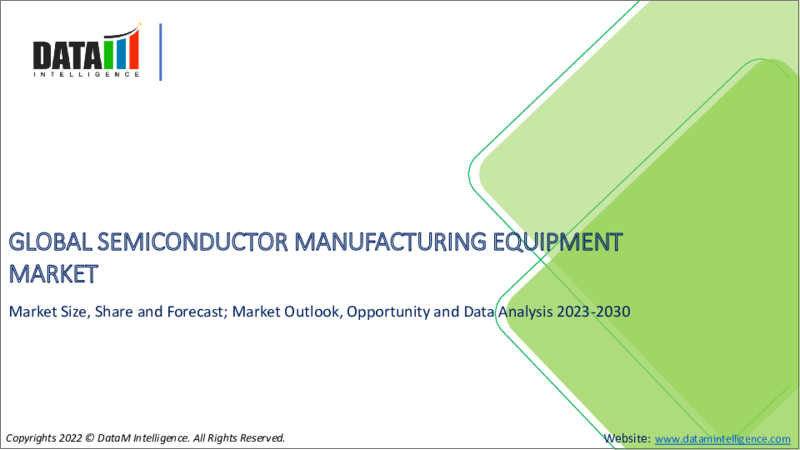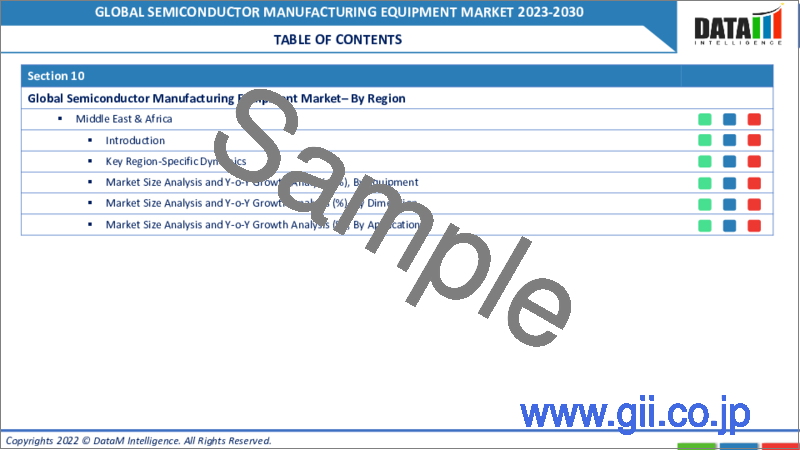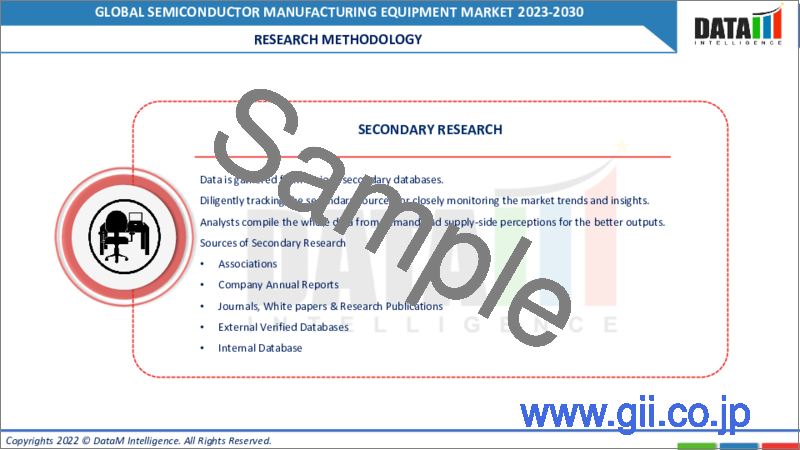|
|
市場調査レポート
商品コード
1304485
半導体製造装置の世界市場-2023年~2030年Global Semiconductor Manufacturing Equipment Market - 2023-2030 |
||||||
カスタマイズ可能
適宜更新あり
|
|||||||
| 半導体製造装置の世界市場-2023年~2030年 |
|
出版日: 2023年07月07日
発行: DataM Intelligence
ページ情報: 英文 180 Pages
納期: 即日から翌営業日
|
- 全表示
- 概要
- 目次
市場概要
世界の半導体製造装置市場は、2022年に806億米ドルに達し、2030年には1,422億2,000万米ドルに達すると予測され、予測期間2023-2030年のCAGRは9.5%で成長する見込みです。
半導体製造装置市場は、スマートフォン、タブレット、ノートパソコンなどの民生用電子機器の需要や、産業用および自動車用アプリケーションにおける半導体のニーズの高まりによって牽引されています。また、より小型で高性能なチップの市場開拓や新材料・新プロセスの登場といった技術進歩も市場を牽引しています。
アジア太平洋地域は、巨大な電気・電子産業基盤を持つため、世界の半導体製造装置市場の50%以上を占めています。同地域で最も急成長しているのは中国であり、インド、日本、その他アジア太平洋地域がこれに続く。
市場力学
ハイブリッド車と電気自動車による新たな道
自動車や産業用アプリケーションにおける半導体の需要が伸び続けるにつれ、半導体製造装置の需要も増加します。こうした用途の半導体を製造するには、パワーエレクトロニクス用装置、センサー製造用装置、マイクロコントローラー用装置など、高度で特殊な装置が必要になるからです。
車載用および産業用アプリケーションにおける半導体製造装置の需要の増加は、今後も半導体製造装置市場の成長を牽引し続けると予想されます。この動向は、自動車や産業用アプリケーションで電子システムの採用が急増している新興市場で特に顕著になると予想されます。
半導体産業の周期性
需要が高い時期には、半導体メーカーは生産能力を増強して需要を満たすために新しい設備に投資します。しかし、需要が落ち込むと生産能力が過剰となり、半導体メーカーは新規設備投資計画を延期または中止することがあります。これは半導体製造装置の需要減退につながり、市場の成長と開拓に影響を与える可能性があります。
さらに、半導体産業の循環的な性質は、半導体価格の変動をもたらす可能性もあります。需要が高い時期には、半導体の価格が上昇し、半導体製造装置の需要が増加する可能性があります。一方、需要低迷期には半導体価格が下落し、半導体製造装置の需要が減少する可能性があります。
COVID-19影響分析
パンデミックは半導体デバイスの需要変動を引き起こしました。ノートパソコン、タブレット、ゲーム機などの民生用電子機器の需要は、遠隔地での作業や娯楽の必要性から増加したが、自動車や産業などの他の分野は需要の減少に直面しました。こうした需要シフトは半導体メーカーの投資判断に影響を与え、装置購入の不確実性につながっています。
目次
第1章 調査手法と調査範囲
第2章 定義と概要
第3章 エグゼクティブサマリー
第4章 市場力学
- 影響要因
- 促進要因
- ハイブリッド車と電気自動車がもたらす新たな道
- 抑制要因
- 半導体産業の周期性
- 機会
- 影響分析
- 促進要因
第5章 産業分析
- ポーターのファイブフォース分析
- サプライチェーン分析
- 価格分析
- 規制分析
第6章 COVID-19分析
第7章 設備別
- 前工程装置
- 露光装置
- 水面調整装置
- ウエハー洗浄装置
- その他
- 後工程装置
- アセンブリ&パッケージング
- ダイシング
- メトロロジー
- ボンディング
- その他
第8章 ディメンション別
- 2D
- 2.5D
- 3D
第9章 用途別
- ファウンドリー
- メモリー
- ロジック
- MPU
- ディスクリート
- その他
第10章 地域別
- 北米
- 米国
- カナダ
- メキシコ
- 欧州
- ドイツ
- 英国
- フランス
- イタリア
- ロシア
- その他欧州
- 南米
- ブラジル
- アルゼンチン
- その他南米
- アジア太平洋
- 中国
- インド
- 日本
- オーストラリア
- その他アジア太平洋地域
- 中東・アフリカ
第11章 競合情勢
- 競合シナリオ
- 市況/シェア分析
- M&A分析
第12章 企業プロファイル
- Applied Materials Inc.
- 会社概要
- 製品ポートフォリオと説明
- 財務概要
- 主な発展
- ASML Holding N.V.
- Tokyo Electron Limited
- Lam Research Corporation
- KLA Corporation
- Hitachi High-Technologies Corporation
- Screen Holdings Co., Ltd.
- Advantest Corporation
- Teradyne Inc.
- Nikon Corporation
第13章 付録
Market Overview
The Global Semiconductor Manufacturing Equipment Market reached US$ 80.6 billion in 2022 and is expected to reach US$ 142.22 billion by 2030, growing with a CAGR of 9.5% during the forecast period 2023-2030.
The Semiconductor Manufacturing Equipment Market is driven by the demand for consumer electronics, such as smartphones, tablets and laptops, as well as the growing need for semiconductors in industrial and automotive applications. The market is also driven by technological advancements, such as the development of smaller and more powerful chips and the emergence of new materials and processes.
Asia-Pacific predominantly holds more than 50% of the Global Semiconductor Manufacturing Equipment Market due to its huge electrical and electronic industry base. China is among the fastest-growing country in the region, followed by India, Japan and the rest of Asia-Pacific countries.
Market Dynamics
New Avenues from Hybrid and Electric Vehicles
As the demand for semiconductors in automotive and industrial applications continues to grow, the demand for semiconductor manufacturing equipment also increases. This is because the manufacturing of semiconductors for these applications requires advanced and specialized equipment, such as equipment for power electronics, sensor manufacturing and microcontrollers.
The increasing demand for semiconductor manufacturing equipment in automotive and industrial applications is expected to continue driving the growth of the semiconductor equipment manufacturing market in the coming years. This trend is expected to be particularly pronounced in emerging markets, where the adoption of electronic systems in automotive and industrial applications is proliferating.
Cyclical Nature of the Semiconductor Industry
During periods of high demand, semiconductor manufacturers invest in new equipment to increase their capacity and meet the demand. However, when the demand drops, there is excess capacity and the semiconductor manufacturers may postpone or cancel their plans to invest in new equipment. This can lead to a decrease in the demand for semiconductor manufacturing equipment, which can affect the growth and development of the market.
Furthermore, the cyclical nature of the semiconductor industry can also result in fluctuations in the prices of semiconductors. During periods of high demand, the prices of semiconductors can increase, leading to an increase in the demand for semiconductor manufacturing equipment. However, during periods of low demand, the prices of semiconductors can decrease, leading to a decrease in the demand for semiconductor manufacturing equipment.
COVID-19 Impact Analysis
The pandemic caused fluctuations in demand for semiconductor devices. While the demand for consumer electronics, such as laptops, tablets, and gaming consoles, increased due to remote work and entertainment needs, other sectors like automotive and industrial faced a decline in demand. These demand shifts impacted the investment decisions of semiconductor manufacturers, leading to uncertainties in equipment purchases.
Segment Analysis
The Global Semiconductor Manufacturing Equipment Market is segmented based on equipment, dimension, application and region.
Industry Consolidation And Increasing Investment In R&D
The semiconductor industry is characterized by high levels of consolidation, with a few major players dominating the market. These major players typically invest heavily in front-end equipment to maintain their competitive edge, which drives the growth of the front-end equipment market.
Developing new and advanced front-end equipment requires significant investment in research and development. As semiconductor manufacturers continue to invest in R&D, this drives the development of new and advanced front-end equipment, contributing to the growth of the global semiconductor equipment manufacturing market.
Geographical Analysis
Asia-Pacific's Growing Electronic Industry Coupled With a Large Amount Of Skilled Workforce
The Asia-Pacific has a large pool of skilled workers, particularly in countries like Japan and South Korea. This skilled workforce is critical for developing and producing advanced semiconductor equipment, which drives the growth of the semiconductor equipment manufacturing market in the region.
Emerging markets in the Asia-Pacific, such as India and Southeast Asia, are rapidly expanding their electronics manufacturing capabilities. This presents a significant opportunity for semiconductor equipment manufacturers to expand their businesses and tap into new markets.
Competitive Landscape
The major global players include: Applied Materials Inc., ASML Holding N.V., Tokyo Electron Limited, Lam Research Corporation, KLA Corporation, Hitachi High-Technologies Corporation, Screen Holdings Co., Ltd., Advantest Corporation, Teradyne Inc. and Nikon Corporation.
Why Purchase the Report?
- To visualize the Global Semiconductor Manufacturing Equipment Market segmentation based on equipment, dimension, application and region, as well as understand key commercial assets and players.
- Identify commercial opportunities by analyzing trends and co-development.
- Excel data sheet with numerous semiconductor manufacturing equipment market-level data points with all segments.
- PDF report consists of a comprehensive analysis after exhaustive qualitative interviews and an in-depth study.
- Product mapping available as Excel consisting of key products of all the major players.
The Global Semiconductor Manufacturing Equipment Market Report Would Provide Approximately 61 Tables, 59 Figures And 180 pages.
Target Audience 2023
- Manufacturers/ Buyers
- Industry Investors/Investment Bankers
- Research Professionals
- Emerging Companies
Table of Contents
1. Methodology and Scope
- 1.1. Research Methodology
- 1.2. Research Objective and Scope of the Report
2. Definition and Overview
3. Executive Summary
- 3.1. Snippet by Equipment
- 3.2. Snippet by Dimension
- 3.3. Snippet by Application
- 3.4. Snippet by Region
4. Dynamics
- 4.1. Impacting Factors
- 4.1.1. Drivers
- 4.1.1.1. New Avenues from Hybrid and Electric Vehicles
- 4.1.2. Restraints
- 4.1.2.1. Cyclical Nature of the Semiconductor Industry
- 4.1.3. Opportunity
- 4.1.4. Impact Analysis
- 4.1.1. Drivers
5. Industry Analysis
- 5.1. Porter's Five Force Analysis
- 5.2. Supply Chain Analysis
- 5.3. Pricing Analysis
- 5.4. Regulatory Analysis
6. COVID-19 Analysis
- 6.1. Analysis of COVID-19
- 6.1.1. Scenario Before COVID
- 6.1.2. Scenario During COVID
- 6.1.3. Scenario Post COVID
- 6.2. Pricing Dynamics Amid COVID-19
- 6.3. Demand-Supply Spectrum
- 6.4. Government Initiatives Related to the Market During Pandemic
- 6.5. Manufacturers Strategic Initiatives
- 6.6. Conclusion
7. By Equipment
- 7.1. Introduction
- 7.1.1. Market Size Analysis and Y-o-Y Growth Analysis (%), By Equipment
- 7.1.2. Market Attractiveness Index, By Equipment
- 7.2. Front-end Equipment*
- 7.2.1. Introduction
- 7.2.1.1. Market Size Analysis and Y-o-Y Growth Analysis (%)
- 7.2.2. Lithography Equipment
- 7.2.3. Water Surface Conditioning Equipment
- 7.2.4. Wafer Cleaning Equipment
- 7.2.5. Others
- 7.2.1. Introduction
- 7.3. Back-end Equipment
- 7.3.1. Assembly and Packaging
- 7.3.2. Dicing
- 7.3.3. Metrology
- 7.3.4. Bonding
- 7.3.5. Others
8. By Dimension
- 8.1. Introduction
- 8.1.1. Market Size Analysis and Y-o-Y Growth Analysis (%), By Dimension
- 8.1.2. Market Attractiveness Index, By Dimension
- 8.2. 2D*
- 8.2.1. Introduction
- 8.2.2. Market Size Analysis and Y-o-Y Growth Analysis (%)
- 8.3. 2.5D
- 8.4. 3D
9. By Application
- 9.1. Introduction
- 9.1.1. Market Size Analysis and Y-o-Y Growth Analysis (%), By Application
- 9.1.2. Market Attractiveness Index, By Application
- 9.2. Foundry*
- 9.2.1. Introduction
- 9.2.2. Market Size Analysis and Y-o-Y Growth Analysis (%)
- 9.3. Memory
- 9.4. Logic
- 9.5. MPU
- 9.6. Discrete
- 9.7. Others
10. By Region
- 10.1. Introduction
- 10.1.1. Market Size Analysis and Y-o-Y Growth Analysis (%), By Region
- 10.1.2. Market Attractiveness Index, By Region
- 10.2. North America
- 10.2.1. Introduction
- 10.2.2. Key Region-Specific Dynamics
- 10.2.3. Market Size Analysis and Y-o-Y Growth Analysis (%), By Equipment
- 10.2.4. Market Size Analysis and Y-o-Y Growth Analysis (%), By Dimension
- 10.2.5. Market Size Analysis and Y-o-Y Growth Analysis (%), By Application
- 10.2.6. Market Size Analysis and Y-o-Y Growth Analysis (%), By Country
- 10.2.6.1. The U.S.
- 10.2.6.2. Canada
- 10.2.6.3. Mexico
- 10.3. Europe
- 10.3.1. Introduction
- 10.3.2. Key Region-Specific Dynamics
- 10.3.3. Market Size Analysis and Y-o-Y Growth Analysis (%), By Equipment
- 10.3.4. Market Size Analysis and Y-o-Y Growth Analysis (%), By Dimension
- 10.3.5. Market Size Analysis and Y-o-Y Growth Analysis (%), By Application
- 10.3.6. Market Size Analysis and Y-o-Y Growth Analysis (%), By Country
- 10.3.6.1. Germany
- 10.3.6.2. The UK
- 10.3.6.3. France
- 10.3.6.4. Italy
- 10.3.6.5. Russia
- 10.3.6.6. Rest of Europe
- 10.4. South America
- 10.4.1. Introduction
- 10.4.2. Key Region-Specific Dynamics
- 10.4.3. Market Size Analysis and Y-o-Y Growth Analysis (%), By Equipment
- 10.4.4. Market Size Analysis and Y-o-Y Growth Analysis (%), By Dimension
- 10.4.5. Market Size Analysis and Y-o-Y Growth Analysis (%), By Application
- 10.4.6. Market Size Analysis and Y-o-Y Growth Analysis (%), By Country
- 10.4.6.1. Brazil
- 10.4.6.2. Argentina
- 10.4.6.3. Rest of South America
- 10.5. Asia-Pacific
- 10.5.1. Introduction
- 10.5.2. Key Region-Specific Dynamics
- 10.5.3. Market Size Analysis and Y-o-Y Growth Analysis (%), By Equipment
- 10.5.4. Market Size Analysis and Y-o-Y Growth Analysis (%), By Dimension
- 10.5.5. Market Size Analysis and Y-o-Y Growth Analysis (%), By Application
- 10.5.6. Market Size Analysis and Y-o-Y Growth Analysis (%), By Country
- 10.5.6.1. China
- 10.5.6.2. India
- 10.5.6.3. Japan
- 10.5.6.4. Australia
- 10.5.6.5. Rest of Asia-Pacific
- 10.6. Middle East and Africa
- 10.6.1. Introduction
- 10.6.2. Key Region-Specific Dynamics
- 10.6.3. Market Size Analysis and Y-o-Y Growth Analysis (%), By Equipment
- 10.6.4.
- 10.6.5. Market Size Analysis and Y-o-Y Growth Analysis (%), By Dimension
- 10.6.6. Market Size Analysis and Y-o-Y Growth Analysis (%), By Application
11. Competitive Landscape
- 11.1. Competitive Scenario
- 11.2. Market Positioning/Share Analysis
- 11.3. Mergers and Acquisitions Analysis
12. Company Profiles
- 12.1. Applied Materials Inc.*
- 12.1.1. Company Overview
- 12.1.2. Product Portfolio and Description
- 12.1.3. Financial Overview
- 12.1.4. Key Developments
- 12.2. ASML Holding N.V.
- 12.3. Tokyo Electron Limited
- 12.4. Lam Research Corporation
- 12.5. KLA Corporation
- 12.6. Hitachi High-Technologies Corporation
- 12.7. Screen Holdings Co., Ltd.
- 12.8. Advantest Corporation
- 12.9. Teradyne Inc.
- 12.10. Nikon Corporation
LIST NOT EXHAUSTIVE
13. Appendix
- 13.1. About Us and Services
- 13.2. Contact Us





